#VISUALS OTHER THAN GRAPHS
Text
I present to you the funniest asoiaf related graph ever, counting the number of Targaryens alive per year.
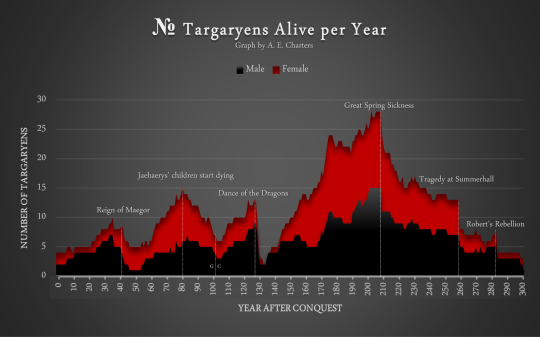
Obviously everyone knows how george comes up with tragedies over the years to whittle down the amount of Targaryen branches hanging around, but it's kind of funny to see it in a visual form. I think the funniest bit of info, aside from the sheer cliff drop due to everyone killing each other over the Dance, has to be how the number of Targs skyrockets after Aegon the Unworthy starts siring bastards. Even after the Great Spring Sickness decimated Westeros, there's still more Targaryens around than there ever was before.
Honorable shout out for the sharp drop once all of Jaehaerys's children start dying like lemmings, though.
#asoiaf#valyrianscrolls#house targaryen#aegon iv targaryen#jaehaerys i targaryen#the dance of the dragons#robert's rebellion#viserys i targaryen
1K notes
·
View notes
Note
I saw your DD graph asking for other ideas, so... if you still have any desire to do further Dracula graphs I'd be curious to see how the word count per character breaks down (not how much they speak but how much they write. Adding all their diary entries together, etc.). Obviously Mina wins by default from having typed up the whole novel but outside of that detail, how much did each person author?
Thank you so much for this ask! What an interesting data set this one is! Lots of unexpected information.
So first off, if you just want to visualize the author breakdown, ta-dahhhh!

Seward was staunchly in the lead, talking his head off and burning through those wax recording drums like no ones business. Poor Mina for having to transcribe it all. In total his words made up 39.3% of Dracula. Nearly 40%!
Seward unsurprisingly had the most individual entries overall at 47, and had the longest streak for being the narrator in an entry at 10 days (09/02 - 09/11) with Mina following right behind at 9 days (08/10 - 08/19)
Mina surprisingly was 3rd overall both in word count and number of entries. She wasn't even in the top 3 for most words in a day which is as follows.
1 - Seward October 3rd - 9942 words
2 - Seward September 29th - 7206 words
3 - Jonathan October 3rd - 5944 words
Van Helsing only had 9 entries total but still came in number 4 for word count, in front of Lucy. It's interesting to note that the amount a person writes doesn't correlate to the amount of time they are being written about/appear. Which is why Arthur and Quincey don't even beat out the newspaper clippings for words, lol.
There are lots of authors we only hear from a single time, like Sister Agatha. So I've decided to make a small fry pie as well. (Authors under ~500 words)
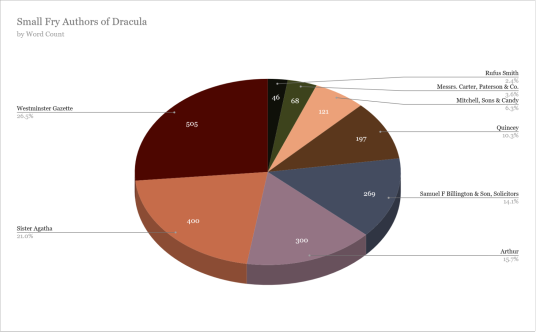
The captain of the Demeter and Van Helsing both had more days written than Lucy! Though I didn't break up number of entries, like when the log of the Demeter had 3 or 4 on one day or Lucy wrote a letter and in her diary.
If there is any data I haven't presented here that you're interested in feel free to tag me or shoot me an ask like this lovely person did!
#dracula daily#this took me 4 hours#potential spoiler#graphs#book data#word count#meta#averages#percentages#dracula daily tracker#dracula entry lengths#dracula authors#dracula meta#jonathan harker#mina harker#john seward#abraham van helsing#mina murray#lucy westenra#dracula#bram stoker#marketpeaches#arthur holmwood#van helsing
388 notes
·
View notes
Text
Today's linguistics adventure: early uses of the word "blog".
I was back-browsing xkcd, as you do, and 1043 is this:
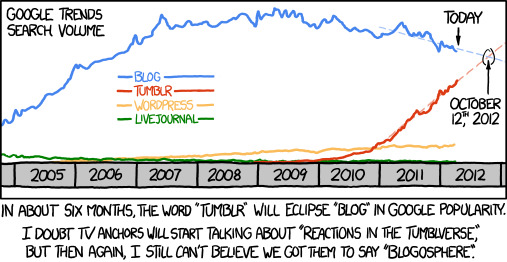
And given the...subsequent developments about Tumblr, I decided to make the equivalent graph today. I eventually found Google Trends, which I don't think is tracking exactly the same thing, but seems pretty compatible:
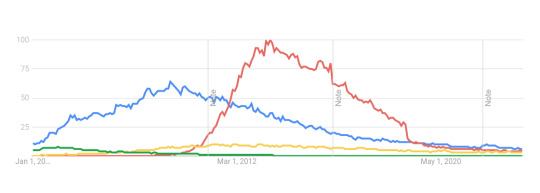
(And it's surprising to me, how long and how late Tumblr had more google searches than blog. I guess people stopped searching "blog" because everything was a blog?)
But before that I reached for ngram viewer, and got something interesting.

In this case, the interesting thing isn't the comparison; everything except blog is a visual flatline.
The interesting thing is, this search defaults to start from 1800. Why are there any hits at all? What's going on with that bump in the 1920s? (And a smaller one in the 1860s.)
Let's trim the ending of the series. We get this:

(Note this means that "blog" was more popular in the corpus in 1920 than in 2004, which seems rather improbable.)
Ngram viewer is drawing from the Google Books corpus, which is, you know, directly searchable. So I looked for hits for "blog" between 1900 and 1940. And the first valid-looking hit is from page 6 of that classic work of literature, Over-the-counter Brokers and Dealers Registered with the Securities and Exchange Commission as of January 31, 1936:
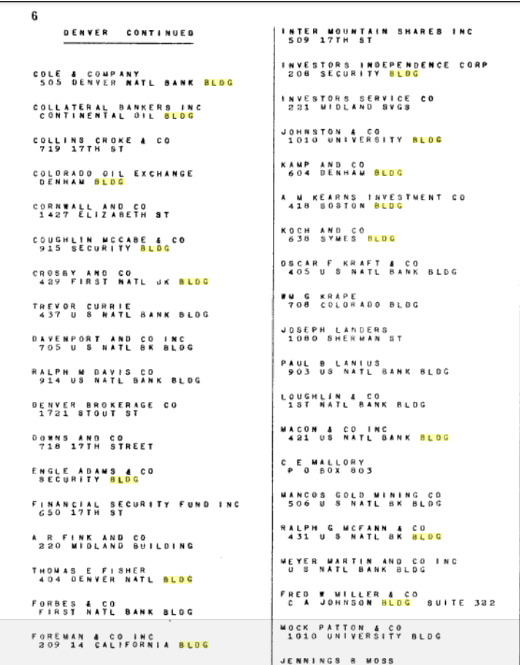
Ah. Problem solved?
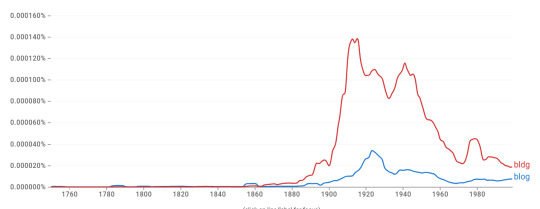
Almost! But now I wanna know what those other two, earlier bumps, are. In 1822 there's an arithmetic book that has stuff like this:

and it does seem like there are a lot more hits like that; I don't know why they're localized to the 1800s though. I think all the early bumps might be from that, though.
239 notes
·
View notes
Text

(nonsensical hrpf data exercise) degree centrality graphing & other archive insights
intro/prior work
hello 🙇♀️ i'm not sure this post will make any kind of sense at all, but i love analyzing ao3 data and i especially find it fascinating in the realm of sports/hrpf because of the amount of player- and team-related attributes that offer dimensionality to fandom analysis when examined in parallel with archive metrics. i've already kind of done hrpf overviews on two separate occasions over the past year or so, but my method of collection differed in each instance and also always gave me new things to chew on and potentially explore, such as expanding on the link between player talent and shippability and whether high-draft picks have more fic written for them on average.
i most recently examined player data based on aggregated relationship counts since 2022, but this was a limited snapshot meant to piece together recent ficdom trends (see top ships since 01/01/22) and not be representative of fandom overall. basically, things i want to visualize/talk about now are:
hockey is so widespread as a sports fandom because there are 32 teams in the league, which when compared to a community like f1 makes it difficult to succinctly summarize primary relationships for. there is no self-contained grid of 20 drivers that remains generally fixed within a season, where every move in/out of that "roster" is highly reported upon and instrumental to fandom makeup, but instead a more amorphous network of malleable rosters featuring high-variance cascading orders of character visibility; in short, the difference between the most and least popular driver in f1 fandom is not the same as the difference between sidney crosby and that one ahl lifer who was called up to your 4th line two months ago because your team is utterly decimated and gunning for bedard.
Still: because rosters are so malleable and trades happen with some amount of frequency, and because hockey is still an "insular" ecosystem in terms of geographic accessibility and junior-age development (for better or worse; mostly for worse, but that's neither here nor there), players intrinsically have a low degree of separation between one another, whether it be as teammates now or as friends growing up in the ohl, ntdp, etc. i therefore wanted to take that a step further and look at it through fic metrics especially: can we use a summary of ficdom's real, tangible output and visualize it through a similar network? (+ where and how does that network differ from player connections in practice?)
back to the impact of draft pick # and assessments of talent relative to popularity, i also wanted to look at the most "successful" ships in ficdom from this network and evaluate the different distributions and impacts of their respective attributes. are certain player positions more popular? which nationalities are the most commonly shipped?
etc. But let's just get into it.
process
getting any kind of information from a 60%-locked fandom on ao3 is a nightmare and introduces a myriad of data-collecting limitations, so i do feel it important to disclaim that what i present in this post functions more in the realm of Approximate Interpretation and Potential Correlation than any actual 100% objective representation of fandom metrics.
a perceived limitation i have with character tagging metrics on ao3 is that they don't exactly reflect shippability; that is, if q.hughes is tagged as a character in a n.hischier/j.hughes fic, it gets attributed to his character tag but doesn't actually say anything about how many Relationship Fics exist for him on a whole. my best solution for this was essentially uncovering most of a player's relationships and summing their individual fic counts to create an approximate # of "relationship fics" for each player. so any kind of shippability graph going forward will use that metric.
i used ao3's relationship tag search and filtered by canonical in the men's hockey rpf fandom and only pulled relationship* fics ("/" instead of "&") with a min. of 20 works. ao3's counts are... Not the most accurate, so my filtering may have fudged some things around or missed a few pairings on the cusp, which again is why all the visuals here are not meant to show Everything in the most exact manner but function more so as a "general overview" of ficdom. although i did doublecheck the ship counts so the numbers themselves are accurate as of time of collection.
(*i excluded wag ships, reader ships, threesomes to make my life easier although i know this affects numbers for certain players, hc/gm ships, and any otherwise non-NHL Player ship. for ex., this eliminated anna kasterova/evgeni malkin, tyler brown/tyler seguin, and kyle dubas/william nylander, just to name a few)
all ship data was collected march 16, 2023.
PART 1. SC87 ship networking
when i first began this exercise i tried graphing ships for all the first-overall picks from 2003-2022 because i wanted to get an overarching sense of their connections. however, doing so made me realize that sidney crosby was by and far the most-connected node in the graph (and basically all hrpf in general) with a degree of 11, and that he was centering one huge component to which only two ships failed to connect (op/kj and slaf/xhekaj). basically:

so then i was like, right! let me instead use sidney crosby as my sole starting node, map out all ships with 20+ works from him specifically, take the players he connects to and map out their corresponding ships (excluding sid) and just keep iterating until i basically reach a final child node. through this, i yielded 112 ships and 98 unique players, with my final connecting node coming 9 degrees of separation away through brady tkachuk ↔ tim stützle/quinn hughes. unfortunately i can't actually host this little code snippet anywhere lol but i also wrote an input to check the pathways between any two players which was kind of fun:

here is the actual network graph with colors from automatically generated clustering, which doesn't really mean much but i thought was one nice way of presenting it. the edge width refers to the sum of fics for each ship and the node size refers to the degree, or number of ships, for each player.

i then also joined my player set with a dataset that included draft year, drafted team, position, etc... and through that color-coded the graph with the team each player was originally drafted to (i always struggle between using current team and draft team because which one matters more is super contextual, but... using draft team made my life easier this time so i hope it's still interesting.) here i only included colors for 13 teams that had 3+ players each:

→ [full-size graph]
we can do a bit more analysis based on this specific sidcros network, like which players are the "most-shipped" or overviewing cross-team shipping tendencies:
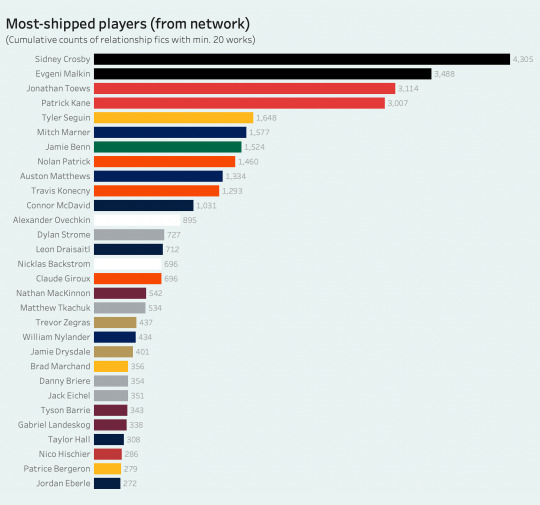
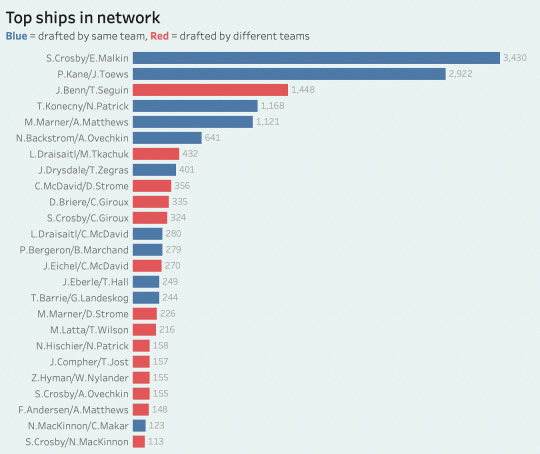
but! of course, not ALL big hrpf ships lead back to sc87. using him as a central node essentially just helped me filter out excess "noise" when searching for relationship tags on ao3, because now i could exclude anyone connected to him at all (note: the relationship fics from my set equaled upward of 19,000 works, accounting for 60.4% of the entire men's hockey rpf archive) and hit other significant tags more efficiently.
through this method, i singled out a new set of 76 ships and 134 unique players (notice the significant decrease in overlap), which i then combined with my sid ships to create one massive set of Hockey Ships With Over 20+ Works On Ao3 that i could analyze holistically. no idea if this makes any sense but bear with me:
PART 2. general ship insights
i won't bore people with endlessly listing out ship rankings but here's the previous top chart with the new ships slotted in:
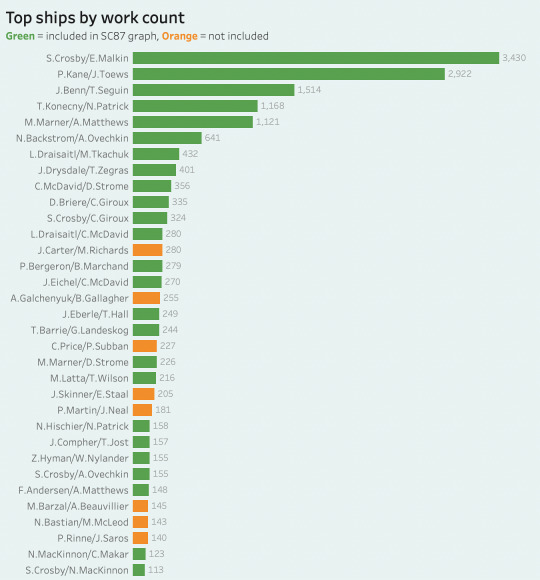
now for some overall player analysis!
first i wanted to look at how attributes like draft round, nationality, and position (F/D/G) are represented in the player set.

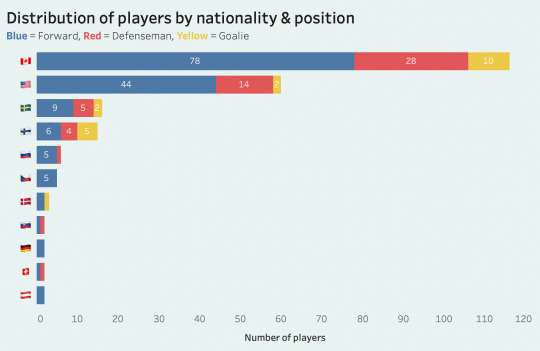
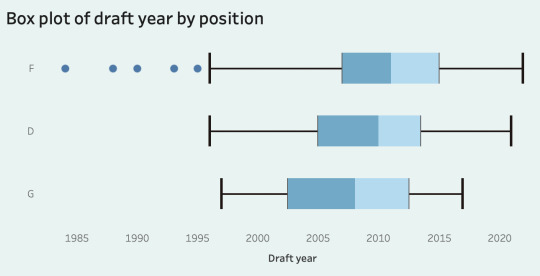
the nationality distribution is pretty close to all active nhl players this season, so there aren't major disparities there. however, the vast majority of players 1) were drafted in the first round and 2) are mostly forwards, with the forwards also seemingly reflecting the general philosophy of faster development/higher recent-round representation. we can take this overview a step further and actually examine the fic averages for each characteristic as a proxy for measuring shippability/ficdom popularity.
first, i scatterplotted all players by their draft pick and number of fic to (try and) show the heavy skew toward top picks (inspired by the gar draft pick value curve and other similar plots). this is... well, limited in many ways, and if i had an actually adequately large dataset i could specifically plot averages per distinct pick number and try to present something there, but the problem is that a lot of these later pick numbers only have like one player so there's way too much variance LOL.
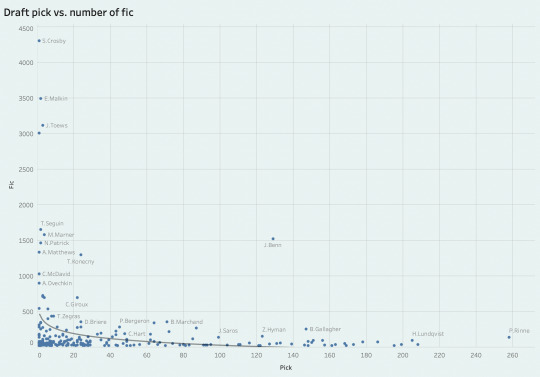
but just for the sake of this exercise i excluded j.benn as an outlier and grouped fic averages by round (left below). again, noting the sample sizes, let's just say that first rounders on average seem to have the most fic written about them, even if it's not a particularly shocking insight. we can also try creating a histogram for "shippability" by draft year, binning here for every 2 years, to see which draft years appear to have had the most success (right below). note the peaks around 2005 and 2015, aka the sc87 and cm97 ~Generational Years~ 🤔
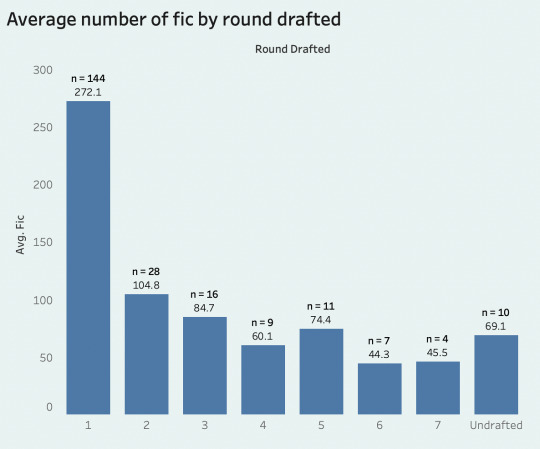
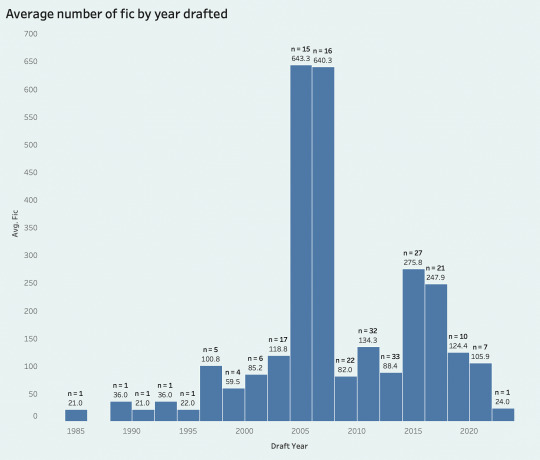
i've also been interested in figuring out which positions are commonly preferred—since centers are so often the faces of a franchise and are essentially the most sought-after position, and since goalies occupy a positionally static role/are less oriented toward contact (and the presumed homoeroticness thereof) in the way skaters are, is that reflected in the fic metrics as well? turns out: yes.
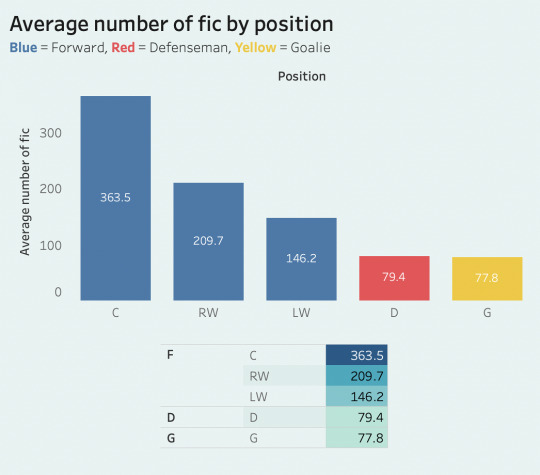
some ship analysis
learning more about player data in a vacuum is fun, but we also have all of this relationship data that lets us examine how different characteristics interact with each other, which is meaningful as well! for example, we know that forwards are heavily represented in the dataset, but is center4center the most common combination? or is there love for a franchise center and his beloved winger or the team's dependable 1d?
(fought for my life trying to figure out how to map this properly so please accept a horrible bar chart instead) as it turns out, the most common combination is centers/wingers, followed afterward by centers/centers. i don't know whether this really means much to me because i'd like to dissect the combos even further (is C/C more often 1C 2C or cross-team rivalry 1C shipping? are C/W usually linemates? etc.) but 🤷♀️ here's a graph.
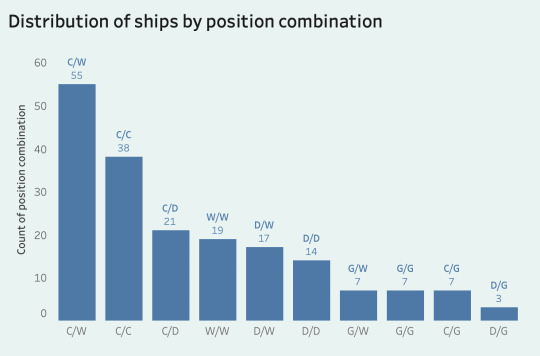
i also distributed ships by their nationality combination, displaying to the surprise of no one a heavy preference (a whopping 66.4%!) for north american-exclusive shipping. i also thought stacking by "draft year" (= averaging the draft year between both players for each ship) offered some interesting insight into usa4usa shipping having slightly younger representation. also i do think usa/germany being singlehandedly driven up this chart by one family is remarkable and hilarious LOL.
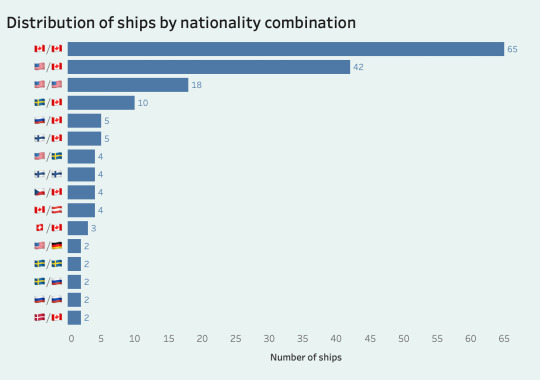
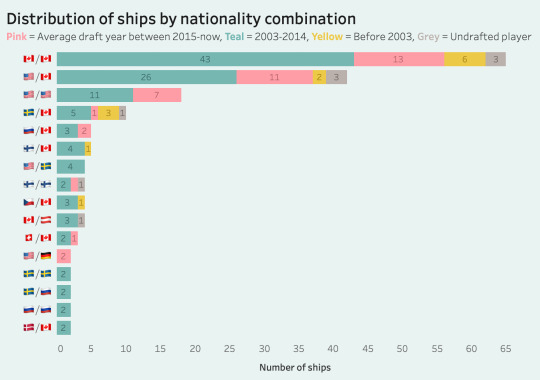
also in the realm of draft year analysis, i wanted to look at draft year differences and whether fandom preferences seem to lie by way of same-age-ish pairings and In-Class Bicycling so to speak. graphing ships by these differences spanned a range of 20 years, with the oldest "age" (draft) difference being 20 years between zdeno chara and charlie mcavoy. overall, of 175 ships with a drafted player, 60.5% were drafted within 2 years of each other (18.2% in the same draft), and only 5% had a draft difference of 10 or more years.
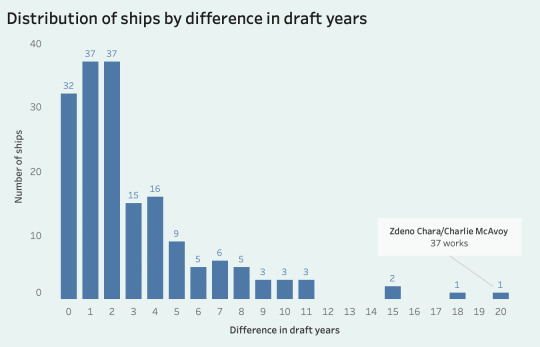
then, of those 32 ships drafted within the same year, i distributed their counts by year to see which draft classes featured the biggest in-class clusters, leading us again to the Famed Class of 2015:
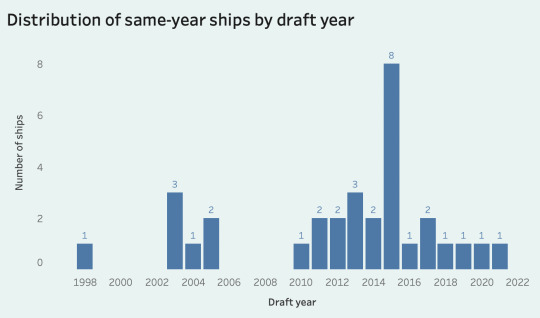
closing thoughts
i'll stop here :saluting_face: something else i had on the agenda that i don't really know how to adequately explore with this dataset is basically stanley cup champion stuff, e.g. looking at players and ships and fic counts from winning teams and how/whether a sort of "winning bias" has been trending down as of late (see the relative success of ships from teams like phi/ana compared to tbl/stl)—temporal data is so particular and difficult to wrangle with ao3 though so i'll have to let this one percolate a little bit.
finally, another thing (!) that i love examining is captaincy and how it often helps inform shippability; C/A/guyswithletters shipping obviously generously overlaps with being drafted early, high-impact players, some positional stuff like Young Star Center having the role foisted onto him, etc. and many of these aspects are immediately identifiable in top ships like 8771, 1634, 1386... just to name a few obvious ones. unfortch i don't really have the time or space to look at that here but it's something i'm still interested in maybe expanding on, and i also never ended up collecting actual skater *performance* data which would be super fun to eventually get to, e.g. mapping ficdom output to not just background identifiers like draft year/pick but also 1) actual tangible evaluations of player goals/points/(salary?!?)/etc. and 2) some dimension of draft outperformance/underperformance, which is pertinent for scenarios like late-round picks who have defied career expectations (see outlier jbenn having a shit ton of lifetime fic) AND early-round picks whose trajectories have not panned out as expected for whatever reason; often the ~tragic~ frustration of being a bust actually invites more narrative focus and scrutiny, but at the same time ficdom trends have pointed themselves to being attracted to many historic, talented, generational, and so on players, who more often than not are also winners, which potentially posits a need for some sustained line of access/visibility to high-expectation players significantly before they're regarded as "busts" in order to organically grow and generate initial interest that can survive the renewed reality of their situation. but who knows
again, i don't know whether any of this even makes sense or is interesting to literally anyone at all, but i personally enjoyed just dicking around graphing shit and getting to join a ton of tables together for absolutely no reason lol. that's all!
477 notes
·
View notes
Note
Hey howdy! I'm working on a project about superhero omegaverse statistics and wondering how you designate someone an alpha vs omega, etc. In your fics you have a wide range of characters' dynamics and interactions with their secondary genders. It is very cool!
Some prompts: How influenced are you by who you're planning to pair them with, vs their individual attributes? Would you say a character's visual appearance/suit affects how you perceive them? What is the defining trait you look to when figuring out whether someone will be an alpha? How does masculinity vs femininity play a role in your choices? What do you like best about the omegaverse?
Anyway, I'd love to hear your thoughts, but no pressure to reply if you don't want to! Ive attached two graphs here for some context: one looking at Bruce's categorization, and the other looking at the link between suit colours & masculinity & secondary genders.


What a fascinating project!! Thank you for asking me.
How influenced are you by who you're planning to pair them with, vs their individual attributes?
Generally I choose the dynamic from attributes and write the pairings from there. The obvious exception is superbat, which is an interesting one for me. I love writing almost exclusive Omega!Bruce/Alpha!Clark but I actually read a ton of Alpha/Alpha superbat, as well as Omega!Clark.
For example, Lex in ASOH was always an omega in my mind, regardless of any plans to pair him off at a later date.
I've found that both Clark and Bruce share attributes that make them both interesting and complicated alphas or omegas. A lot of them are tied up in their perceptions of themselves, as well as the public's perception of their identities/secret identities. I will say that Bruce's public Brucie persona and his Batman persona lend themselves very well to the duality of what the public assumes omegas are, versus what omegas want to be -- or can be. I also think his bonds with family/pack lose a bit of complexity when they're reduced to him being a possessive or strict alpha over a pack.
Would you say a character's visual appearance/suit affects how you perceive them?
Sometimes! I think the tendency to slap an alpha label on all big, bulky guys is funny, because in ASOH I've been doing almost entirely the opposite -- all of the big bulky guys (except Clark) are omegas! I like flipping those long-standing fic tropes on their heads.
But yes, I am no exception to this trend either. I think the more interesting question is, is this trend exclusive to alpha/omega dynamics? Or do we also classify betas this way too? Dick is a beta in several batfam fics I've read -- is this just because he's a little smaller/slimmer than Jason, etc? Or is it because of characteristics he holds that we attribute to betas (calm, reassuring, playing peacekeeper, etc)?
What is the defining trait you look to when figuring out whether someone will be an alpha?
I'm not sure there's just one. I think most characters can be written convincingly as different kinds of alphas. But generally, presence is one trait that comes to mind -- when they want to. if they want to -- are they able to take up a room with sheer aura alone? Do people look to them for advice and direction? Are they self-confident and strongly-motivated? Do you want to bop them on the head every now and then because they're being a little ridiculous?
How does masculinity vs femininity play a role in your choices?
There's been a lot of dialogue in fandom and fanon about the feminization of certain characters in pairings because of/related to omegaverse. I try my best to challenge those longstanding trends or biases when I see them pop up in my work. One example of this is use of gender neutral words for omegas who are having pups -- I started using "carrier" instead of "mom/mama" because I think allowing male omegas to retain their masculinity in pregnancy is important (if desired). Otherwise we reduce child carrying to something inherently feminine, which, especially in the omegaverse, is simply untrue.
What do you like best about the omegaverse?
It's a great way to challenge ideas about gender in new and interesting scenarios. With the inclusion of instincts and heats/ruts, there's also a lot of forced proximity and decisions made under shades of duress. There's a lot of space there to explore sexuality and the socialization of genders IRL and in universe. How much of what we do truly is instinctual or biological? How much of it is simply how we were raised/raise our own children? Is reproduction truly the end all be all of a person? What happens when we buck society's expectations and forge our own path forward? How can we better foster non-sexual relationships and bonds between family and friends?
#asks#anon#a/b/o mention#a/b/o tw#mpreg mention#mpreg tw#myfic#theresurrectionist#a sky of honey#pack dynamics#amazing ask#hope this was at least a little helpful!
87 notes
·
View notes
Text
Hello! Here is data on point of view distribution across characters in The Dreamer Trilogy (which I will abbreviate as TD3) as a follow up to my TRC data from last year (viewable here). A rather long-winded discussion of the data, methods notes, and some supplemental figures and tables are under the cut. As it was not possible to include all values and stats in this post (nor in the alt text for image IDs), my spreadsheet can be viewed by clicking here,




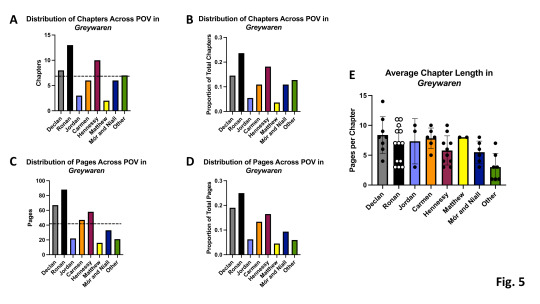
This project quantifies and visualizes the distribution of chapters and pages in the books of TD3 across characters from whose POVs the story is told. I didn’t have much of a hypothesis going into data collection/analysis, especially not like I did for the TRC data, but I did expect to see Ronan’s POV having the most chapters and pages for the entire series, given the fact that he is the most central of the protagonists. I don’t think page time is the be-all-end-all for a character’s importance, of course, but it is still interesting to consider how spending more time from certain perspectives affects the perceived narrative. I won’t get much into that aspect of analysis in this post, but if anybody would actually like to discuss that, I’d love to!
Results (and Interpretation):
TD3 consists of 173 chapters and 1184 pages (using the U.S. hardcover editions), making the average chapter 6.84 pages. The longest chapter is 16 pages, and the shortest is 1 page.
Figure 1A: The average chapter in Mister Impossible (MI) is considerably longer (9.26 pages) than the average chapter in Call Down the Hawk (CDTH) (6.00 pages) and in Greywaren (GW) (6.40 pages), which makes sense as MI has just 38 chapters while CDTH has 80 and GW has 55 (see Fig. 2). To me, the effect of the longer chapters (and therefore extended time with the current POV character) makes the various POVs feel more temporally distant from one another- not in a narratively incoherent way, but in a way that echoes the sense of isolation experienced by dreamers and weaponized by Bryde as he tries to convince Ronan and Hennessy to abandon their loved ones.
Figure 1B: Chapter length is fairly consistent amongst POVs across the series. Matthew has the longest average chapter length (8.40 page) over a small set of chapters (5 total)- his character development (as told from his own POV) is limited to a small number of instances, which may have stretched his chapters a bit longer. The 'Other' category has the shortest average chapter length (5.13 pages) (Fig. 1B); it includes the typically short chapters from witnesses of Visionary explosions/aftermath (Mags, Dabney) as well as Nathan's manifesto excerpts. (As a side note, I've described the chapters depicting memories from the Barns as 'Mór and Niall.' These chapters do not collectively portray an equal balance of their POVs, but this was the simplest way to categorize them.)
Figure 2A-B: These graphs are representations of chapter distribution across POVs in TD3 in terms of chapter count (2A) and proportion of total chapters (2B). Some observed trends include Declan's proportion of total chapters remaining quite constant throughout the series, Ronan's decreasing, Hennessy's proportion of chapters nearly doubling from CDTH to MI (and staying at a similar proportion to MI in GW), and Jordan's proportion following an opposite trend (consistent proportion in CDTH and MI, followed by a more than 50% drop in GW). Carmen's proportion of chapters also declines after CDTH.
Figure 2C: This graph compares total chapters per character POV over the entire series. We can see that the largest proportion of the series is told from Ronan's POV (53 chapters, or 0.306 of all chapters). To put that in perspective, Hennessy has the next highest number of chapters (26, or 0.150 of all chapters), which is just under half the number of Ronan's. If all characters had an equal number of chapters from their POV (including the miscellaneous POVs as one category labeled Other), they would each have 21.6 chapters, represented by the horizontal dashed line; Declan, Jordan, Carmen, and Hennessy all have chapter counts relatively close to this number.
Figure 2D-E: These are representations of page distribution across POVs in TD3 in terms of page count (2D) and proportion of total pages (2E). Trends are similar to those depicted in 2A-B, but 2E does make Declan's increased proportion of page time in GW salient.
Figure 2F: This graph compares total pages per character POV over the entire series. The dashed line shows that if each character (plus the Other category) had equal page time in the series, readers would spend 148 pages with each POV. Again, page data is similar to chapter data, but comparing graphs 2C and 2F gives a clear visual indicator that Jordan's chapters (on average, 8.11 pages) are longer than Carmen's (on average, 6.08 pages), since Carmen has visibly more chapters in 2C yet nearly the same number of pages as Jordan in 2F.
Figure 3: Figure 3 shows distribution of chapters (3A-B) and pages (3C-D) in CDTH, as well as average chapter length for each character POV (3E). An equal distribution of chapters would have been 13.3 per character, and an equal distribution of pages would have been 80.0 per character. The 'Other' category included chapters from the perspectives of Lock, Breck Myrtle, Shawna Wells, Jason Morgenthaler (and Lin Draper, briefly, in the same chapter), Mags Harmonhouse, and Dabney Pitts. Carmen's average chapter length in CDTH (4.67 pages) is the lowest single-book average for character POVs appearing throughout the entire series. (Nathan's average chapter length is just 1.00 [Supplemental Figure 2], yet his POV only appears in GW via his manifesto excerpts, and while I have attributed these chapters to his POV, I interpret the POV as actually ambiguous. As with Kavinsky's text in TDT, it's not absolutely certain if we are reading from the writer or the reader's perspective [although in TDT, due to the lack of Kavinsky POV elsewhere, it's probably the latter]).
Figure 4: Figure 4 shows distribution of chapters (4A-B) and pages (4C-D) in MI, as well as average chapter length for each character POV (4E). An equal distribution of chapters would have been 5.43 per character, and an equal distribution of pages would have been 50.3 per character. The 'Other' category included two chapters, both with what I deemed omniscient narration. Declan had the shortest chapters in MI (8.20 pages), and Jordan had the longest (11.4 pages, the longest average for a character for a single book in this series).
Figure 5: Figure 5 shows distribution of chapters (4A-B) and pages (4C-D) in GW, as well as average chapter length for each character POV (4E). An equal distribution of chapters would have been 6.88 per character, and an equal distribution of pages would have been 44.0 per character. The 'Other' category included Nathan's manifesto excerpts (3 chapters), 1 chapter from Liliana's POV, and 3 other chapters with omniscient narration. While Ronan never has the longest chapters, his chapters are shorter relative to other POVs in Greywaren, perhaps as a result of the way his chapters are written during his time asleep/in the sweetmetal sea. I have not yet investigated whether chapters tend to be longer while characters are awake vs asleep or dreaming, but that's something that could be measured from the existing data in the spreadsheet! There is also a dramatic drop in Jordan's POV time in GW compared to the previous two books, perhaps because of her increased divergence from Hennessy and desire to establish a life that follows her own narrative.
Other findings: A major difference I noted between TRC and TD3 was the lack of split chapters in TD3. In TRC, the data analysis was made slightly complicated by having to account for the fact that a non-negligible number of chapters would make a distinct and discrete switch between POVs partway through. While I did not observe this in TD3, I did encounter more ambiguous/nebulous POVs as I previously mentioned. The increased presence of omniscience in the trilogy, for me, contributed to the increased sense of scale and stakes compared to TRC. This increased continuity amongst POV (not amongst core/recurring POV characters, but amongst groups of characters/communities depicted in the omnisciently narrated chapters) also contributed to a sense of dissolution of barriers and identities, perhaps thematically in line with Ronan's character development and increasingly holistic perspective of both his humanity and otherworldliness (although Ronan is not necessarily featured in these 'boundary-breaking' chapters). I also briefly looked at occurrences of back-to-back chapters from the same POV; this happens most frequently for Ronan in all three books, mainly in CDTH, and sometimes featuring a dreaming chapter directly before an awake chapter (or vice versa) in immediate succession. Declan (MI), Carmen (CDTH), and Jordan (CDTH) all have a pair of back-to-back chapters at some point in the series; Hennessy has 2 (MI, GW).
Conclusions: In all honesty, despite this project being quite fun and fulfilling and of course, worth doing, I do not think I have any particularly insightful conclusions about the data beyond what I've already discussed. Ronan took up the largest share of the chapters and pages as expected, although I am not sure I expected this to be true by such a large margin. I also was surprised that Declan did not have more chapter/page time, but it is possible that his notable inclusion in chapters from other characters' POVs increases his prominence in the series (and I suppose this is probably true for all characters who frequently appear in chapters outside their perspective). As with TRC, the number of POVs expands as the series develops, often with the effect of increasing the scope of the story's implications, and perhaps, more importantly, showing the story from additional angles that contextualize and/or distort narrative established by other characters' perspectives. I hope you've enjoyed exploring the data as I have, and those interested in my methodology may continue reading below!
Methods:
Data collection was straightforward in the sense that I simply counted the pages in each chapter and then assigned each chapter to a character based on the POV represented. The POV character assignment was more difficult than it was for TRC, as TD3 has more omnisciently narrated chapters, which in itself is easy to categorize, but they often zoom in on or are 'biased' towards the experience of a particular character, so I had to make some decisions as to what, for me, constituted sufficient focus on a character’s internal narration and expression vs. omniscience. In the spreadsheet, I took notes on these more subjectively driven decisions. Again, you can view it here! It also contains data on whether the chapter is from an awake or dreaming POV, and has the first lines of each chapter, among which are some fun repeating patterns.
For bar graphs with dots, each dot represents a single chapter. You may also notice that the graphs are missing p-values from statistical tests this time around! This is because, since completing the TRC data, I’ve realized that such measures of uncertainty re: significant differences are not appropriate for my dataset, which is not a sample representing a population, but rather a complete group of chapters (so parametric tests are not necessarily helpful or valid). However, I still like to run the tests for my own amusement and to see what the results would be if this were a dataset for which ANOVA and contingency tests were appropriate, so I have standard deviation bars on the graphs where calculable (but no standard deviations in the text of the results section for legibility) as well as the p-values in tables at the end of this post for anyone also curious. I did still calculate the numbers of chapters and pages that would represent an equal distribution across POV characters, which are represented by the dashed lines on the relevant figures. I think this is helpful to visually gauge 'over-representation' and 'under-representation' of character POVs.
Below are the supplemental figures showing all character POVs rather than lumping some together in an 'other' category. The MI data in figure 4 is not expanded below because the chapters designated as 'other' were omniscient and thus would have remained in the same category.
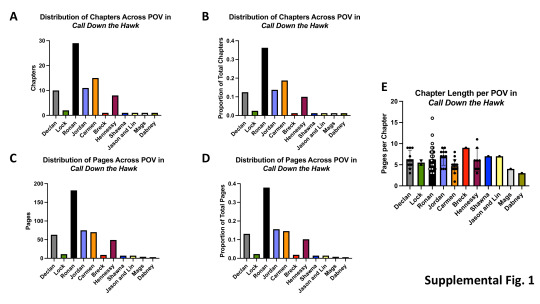
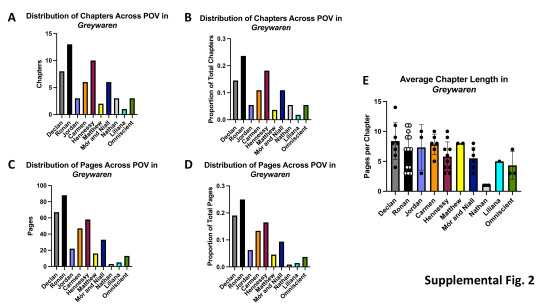
And finally, here are the omitted p-values, if you'd like to pretend along with me that all the chapters in TD3 are not a complete set but rather a representative sample of a greater population of chapters that's out there in the universe. :) When I give a p-value below the 0.05 threshold but still write 'no significant differences amongst any combination of characters, I mean that the p-values generated for the comparisons between each possible pair of characters were all above 0.05, which are distinct from the overall p-value generated from the ANOVA.


#the dreamer trilogy#call down the hawk#mister impossible#greywaren#ronan lynch#declan lynch#jordan hennessy#carmen farooq-lane#long post#rchl#now onto more qualitative/linguistic things! xoxo
102 notes
·
View notes
Text
The Adaptation That Shall Not Be Named aside, I had an idea for an interesting way you could represent ART in a visual medium: it's cameras.
We know that, in any visual medium, what The Camera (be that literal in film or figurative in animation) chooses to show and focus on is important. Its the primary way the piece of media communicates to its audience, and the framing of a scene tells us a lot about how we're supposed to interpret it. What is on screen and how it's on screen convey authorial intent.
Take all that, and turn "authorial intent" into character expression (in this case, for ART). A conversation between Murderbot and ART that would traditionally be shot-reverse-shot becomes shot-ARTPOVshot, so both shots would be of Murderbot, but one would be from The Camera and one would be from ART. Even though the subject is the same, the difference between them could show us something about ART in the same way a reverse shot shows us something about any other character.
To me its like those shots from a monster's POV in horror movies, where one second you're with your protagonists, the next you're watching them from a far off angle between some blades of grass, shaky cam, ragged breathing. It's a classic, even a cliche, but it does the job of conveying the sense of unsafety, of Something Out There Watching Them, of monstrosity, of something feral and dangerous. All without needing to see the monster. What if that type of shot was all we ever got of a character?
(Also, in all honesty, some of my favourite meta about this series is how it's in conversation with the horror genre. ART and SecUnits being the type of characters that would be The Monster in another story, or from another perspective, is compelling to me, so i'm drawing on that a bit here. The idea of characterising but not visualising ART by taking pages out of horror monster cinematography? I just think it's neat.)
Anyway, you could also do all the sci-fi Augmented Vision stuff with it too. ART POV shots where we watch it pull up a feed tab over the camera feed and replay a section of audio, or check Murderbot's diagnostics, or look at Some Code Or Perhaps A Graph. ART POV shots that are broken into multiple feeds showing different things. ART POV shots that give you the sense of it being textually present without it being physically present.
You could use some of this for Murderbot itself, if you leant into how its drones are an extension of its awareness. You could even use it in a similar way to how Murderbot uses its narration, narrating less when it's upset as well as leaving out major details. What if, when Murderbot is tired of people looking at it or in a more vulnerable headspace, we get more drone POV shots without Murderbot in frame. It's still there, but present in a different way, behind The Camera rather than in front of it.
I think there's potential in using POV shots from ART's cameras to characterise it without visualising it in a traditional way. I think there's potential in using horror movie monster language on ART and Murderbot. I think there's potential in having the cinematography focus on what they're seeing in a way that emphasises the amount of Surveillance both of them are constantly doing.
I think there's potential in a show using The Camera as cleverly as the books use Narration.
#like can you IMAGINE.#“You dislike your function.” [subtle zoom on MB's face to see its reaction]#a human asking MB a person question and rather than the cut close up to see its reaction#the camera cuts away so its no longer even in frame#what does MB sending its GovernorModulePunishment.exe to ART look like from ARTs POV???#that one time MB shut down after ART probed too much and ART just waited until it woke up.#its just a ART cam timelapse of MB lying Unmoving for three hours#do you see the vision???? am i crazy????#murderbot#the murderbot diaries#art/perihelion#murderbot meta#stuff i made
141 notes
·
View notes
Note
Got any good resources for clothing drawing tips?
Okay so quick little introduction before I try to answer this question. First of all, sorry for letting this languish in the inbox for so long. I have a lot I want to say about this and I'd really like to make a proper "tutorial" but this week took a lot out of me so what you're going to get are some visual notes on graph paper and some rambling thoughts. Maybe down the line I'll try to flesh this out more into a proper guide, but for now it is what it is.
Second- for many different art concepts I can give you some really great recommended reading for self-teaching. There's a whole section of my website with links to things that helped me learn. Clothing is one of those things where I never found a book or tutorial that really "clicked" with me. It's one of the few areas of art where I feel like it's fair to say I'm genuinely self-taught. So what you're going to get here is very much my opinion, not undisputed common wisdom or whatever. Take it with a grain of salt. This is how I draw, not the "right way" to draw.
Third- drawing clothes is not something fundamental like perspective or rendering where there are actual hard-and-fast "rules" you can learn to guide you. It's not even like anatomy where there are approaches that have been worked out and passed down by artists over generations. I think about drawing clothing as a synthesis of several different skills- a little bit of anatomy, a little bit of perspective, a little bit of rendering. Honestly a smidge of graphic design. You're employing a "cloud" of your artistic skills towards a specific end. What this means is that the TLDR of this post is going to be "do what you would normally do to improve at drawing but apply it to clothing." So don't expect something life-changing, instead just open your mind to maybe trying some new things you hadn't thought of before. Also this is going to be more about drawing than painting, that is more about "lines" than "shapes" but the two skills overlap and the same concepts should be broadly applicable. But my examples are going to be drawings.
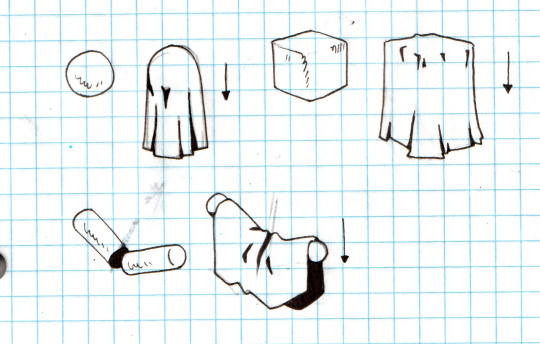
Okay intro out of the way. Clothes are mostly just tubes of fabric, fabric wants to fall down. The human body and sometimes wind and water and other fluids will stop this fabric from falling down all at once and instead give it a shape. Keep this in mind. It's helpful to know how clothes are actually constructed if you want to know how they will deform when falling across the figure. Where a garment is simply a length of fabric, it's very flexible. It can bunch together or be stretched taught. This is most noticeable at the parts of the body that open and shut like hinges- knees, elbows, and armpits. The behavior of garments at these areas of the body is highly dynamic.
At seams where different sections of fabric are stitched together, movement can be come more limited. Seams are usually imperfect- pieces of fabric of slightly different lengths might be stitched together or fabric may shrink over time around a thread causing it to pucker and wrinkle. For these reasons, seams often act as the originating areas for folds and wrinkles, even when a garment is not in a particularly flexed/active state.
In a two-dimensional image, it can be helpful to describe a garment in terms of silhouette and wrinkles/folds. The silhouette is the actual boundary of the garment, where the fabric comes to an end. The wrinkles/folds are where different parts of the garment pass in front of each other or where the fabric becomes bunched up to the point that light can't reach inside and occlusion shadows form. You should always keep the overall silhouette of the garment in mind to inform the bigger shapes you draw, but you will use wrinkles and folds to demonstrate how the garment twists and deforms. These are the basic tools in your arsenal. Keep it simple.
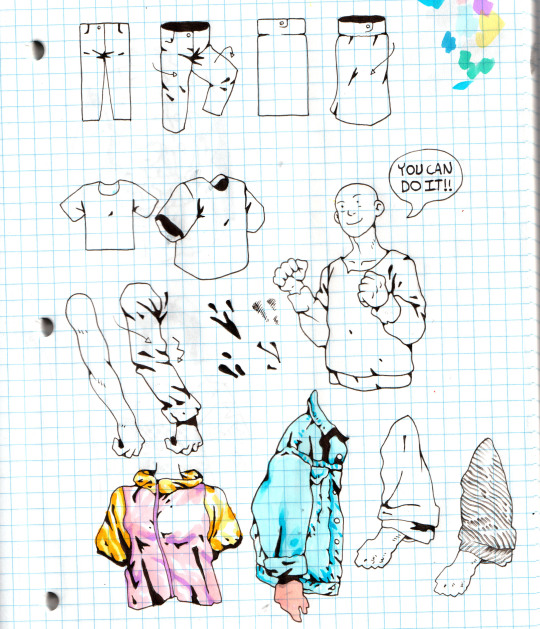
There are lots of different ways to approach wrinkles. My advice and my personal preference is to draw wrinkles as shapes and not just lines. Specifically, tapered shapes (like triangles) and be really good both for implying motion and the varying depth of a fold/wrinkle. Experiment with different shapes of varying angularity, fill texture, etc. Your hands and eyes will guide you towards what looks and feels good. There's no right way but I would advise you to exaggerate! Ask yourself- what's the biggest shape I can draw here? How can I twist it to make it bigger, crazier but still describe the form in a way that makes sense? It can be exhausting to just try to perfectly copy a reference and also using your imagination like this when doing studies will help build up your visual library for when you're drawing/designing clothing from imagination. In general I would advise you to focus more on drawing something that looks good (ie is composed of shapes that you find aesthetically pleasant) than is "correct."
Quick recap: Garments fall down, you can simplify an article of clothing into a silhouette described by folds and wrinkles. What next? Observe! Take notes! It is worth your time to think about how common articles of clothing are constructed. Jeans, t-shirts, dresses, etc. I used to do some hobbyist sewing and clothing alteration and I think that hands-on work with clothes has really affected the way I think about drawing them. You don't have to go that far but like- look at the world around you. Stuck on the bus, in school, in a meeting, etc? Even if you can't draw, look at how your pants bunch up around your legs, look at the sleeves of someone sitting next to you. I mean, don't be weird about it, but these are valuable observations. Think about how you would draw those things! Really getting good at drawing clothes involves studying them in the wild, understanding how they work, building up your visual library. Look at a faded denim jacket- at the puckered places where the indigo has rubbed away or the permanent creases that hardly see the light of day and remain a deeper blue. Look at petrochemical techwear outfits that break into jagged, high-sheen triangular wrinkles. Soak it all in!
Save pictures of and take notes on outfits you like, designers you like, garments you like. Keep track of these things. Come back and study them over time. Have fun with it! I have folders and folders and folders of images of clothes that I come back to constantly. Over time and with lots of study you'll learn what you want to draw when you draw clothes and that's half the battle. You'll have images of buttons, pockets, belts, laces, fabrics, seams, dancing around in your head that you can deploy at will. It's delightful.

Hope this helps! If anyone has more advice to add, please do! If this tutorial helped anyone, please show me your drawings! If you'd like more stuff like this from me, just send me an ask or an email and I'll answer it when I can.
Peace,
Logan
389 notes
·
View notes
Text
so I saw a post that was like “which NC were better kinnporsche or love in the air” and it made me think about sex scenes in BL/GL in general right, so like I know everyone jokes about kinnporsche being the “fuck nasty” show and like it is but it’s also closer to erotica than smut which is what love in the air leans more towards. now before ppl get all twitterpated and shit calm down i’m NOT saying lita is “bad” b/c it’s smutty. smut in general has a bad reputation b/c America is a puritanical society and most smut based romance media (like novels and film) are geared towards women but smut as a sub-genre of romance isn’t inherently a bad thing it’s just A Thing
my point is there’s a scale when it comes to NC scenes that I’ve noticed especially in more recent years, you have shows that lean more towards erotica - sexually explicit, but also with a focus on sensuality and passion - and other shows that are like, let’s go to pound town and have fun with it. Both are 100% valid, I don’t think either is “better” than the other they can coexist not everything is a competition
here’s a visual example of what I’m talking about:

forgive how messy my bisexual graph is but on one end you have Kinnporsche which are on the extreme end of Erotica: there’s nudity, and clear explicit sexual activities happening but there’s also an emphasis on passion, sensuality and emotion.
Take the infamous handjob scene in KP, yes they fucking nasty in Vegas bathroom rip Vegas taking those L’s but also there’s a focus on the line of Porsche’s waistline, there’s the close up of their faces as they find ecstasy, and the scene doesn’t end in climax but in an embrace with the camera lingering on their emotions.
In comparison to something like, LITA where the sex is much more straightforward (but no less good or whatever! again this isn’t a competition!!! both work and both are valid) there’s not a LACK of passion in LITA it’s just presented in a more straightforward manner.
You could argue that the real different between erotica and smut is how pretentious you wanna be and I implore y’all to argue that b/c I love seeing literary ppl get cranky lmaoooooo
Then you have shows like Big Dragon, contains nudity and the music etc it’s going for erotica - personally don’t think it fully accomplished that goal due to editing but it tried! - similarly Moonlight Chicken went for a more erotic and sensually route but kept it very, very tame so it leans more towards that middle section which is like, there’s the acknowledgement of sex happening but that’s kinda it. It’s acknowledged, Dean wants to bone Pharm, Pharm’s shy about it, they bone but it’s extremely non-explicit (which is ALSO fine again no competitions here) meanwhile on the other end of the scale you have shows that lean more towards smut, tharntype falls into this while it’s not nearly as explicit as Check Out or LITA it has That Vibe like if Mame was allowed and if MewGulf were down it probably would’ve been more explicit but overall it was just really horny.
I forgot to add Cutie Pie into the mix to which I woulda put it probably between UWMA and Moonlight Chicken, it also goes for a more sensual route but keeps things extremely tame in terms of presentation. Like yeah there’s tongue kissing but the energy is pretty tame
anyways
#big dragon the series#kinnporsche#moonlight chicken#tharntype#love in the air series#lita the series#chaos pikachu speaks#this isn't a this is good this is bad take#I can't emphasize this enough b/c ppl always be reading into shit#it's a here are two different styles of sex in media#here's the different ways these things are explored in media#and that's interesting!#chaos pikachu metas
295 notes
·
View notes
Note
I make video essays (not frequently but I'm trying to get back into it) and I have wondered about blind accessibility before but I haven't really found much information that isn't VERY general. Do you have any resources or tips? Because frankly, the reason I make video essays and not say podcasts or just blog posts about these topics is because it is both an audio and visual medium. I can show graphs for things, play clips of movies or songs, etc. and I use captions but when I search for how to make it accessible for the blind all the information I find isn't that applicable to content that's as, dynamic I guess. Like the most common things I see are "identify who's speaking" or "read out text" (which I generally do) but what about clips from other media, graphs, things like that? Especially if im talking about a visual topic like set design or something.
n.b. I'm not blind or low-vision & I'm just brainstorming here.
image descriptions & accessibility aren't quite one-size-fits-all, because thoroughness always comes at the expense of time. you have to ask yourself what information you're trying to communicate with an image or clip. if the entire video is an analysis of a visual artwork, for example, you'd want to describe the image in enough detail that people could not only understand your analysis, but also come to their own analytical conclusions. if, on the other hand, you're just pasting in a line graph to compare two of the numbers in it as a smaller part of a larger point, it's not necessary or worth it to state every value of every variable at every point in time on the graph... just give an idea of the trend you're referring to.
some thoughts:
Any image description is better than no description. Briefly describe something rather than allow the thought of describing it thoroughly to overwhelm you such that you end up doing nothing.
Relatedly: don't think of things in terms of "is the exact same amount and type of information available to sighted and blind people watching this," but rather, "without the visual component, does this basically make sense / can I basically follow the main point?"
What this means is that at no point should there be information that is solely visual in nature, like my example of several seconds of silence where you can only assume that there's probably text on the screen but have no idea what that text says and whether it's a clarification, disclaimer, or even a retraction. It would be best to read this text out, but I've also seen a "text on screen" section in the description box of a video that gives the text in full and the time stamps at which the text appears.
Briefly state what it is about a clip or graph you're inserting that makes it useful for your point. Rather than "and you can see the results of that decision here *a few frames of a graph*," say "and you can see the results of that decision in the sharp downward turn in profits starting in 2009 *a few frames of the graph*." If it's available, link the source of a graph or chart in the description box—it may have alt text or be screenreader accessible at the source website.
Inserting a brief image description into the script after introducing e.g. a photo of a set should be feasible enough, but I also think it's possible to fold the image description into the analysis. This just means making sure that there's never a visual component with no audio equivalent—rather than saying "the stuff that's going on back here *circle part of the screen* has a haunting effect," say "the fact that the furniture in the background is jumbled, worn down, and uncomfortable-looking has a haunting effect." I think explicitly pointing out what about a scene you're responding to is just part of good analysis anyway!
Introduce a clip with a rundown of who's speaking in it and what's going on ("you can see [main point] in this clip, in which Elizabeth confronts Darcy about his meddling in Bingley's affairs"). Play the clip, and then describe anything else about it that's relevant to your analysis ("the fact that she's sitting while he paces back and forth indexes the relationship between gender and space in the film" or whatever). Again, this is just good analysis.
If there's something really central that would take a long time to describe, you could use the description box to image describe it (the same way you would write any other image description) and give a timestamp, and say something like "image description in the box below" when you reach that part of the video.
Sometimes at poetry readings, conferences &c. I've seen people give a description of their appearance, what they're wearing &c. before they begin speaking. I'm not sure how necessary this is—probably some blind people find it interesting and others think it's a waste of time, lmao
114 notes
·
View notes
Text
Best Tools to Track Your NaNoWriMo Progress
The NaNoWriMo site allows anyone who signs up for a free account to set their word count through their dashboard. There are plenty of other resources to help you too, but if that’s not your style, these are other tools to track your NaNoWriMo progress. See if you like any before November begins to tackle your manuscript even faster.
Note: None of these are paid promotions or affiliate links. They’re just recommendations based on what I and other writers have found helpful in the past!
1. FocusWriter
Writers often start exploring the world of creative writing tools by downloading FocusWriter. The free program hides everything on your screen except your document and shows a custom background instead, like the wooden background below.
Use the settings to customize each writing experience and keep track of your daily NaNoWriMo word count goals. It even spell checks for you, which speeds up your editing process.


2. NovProg
NovProg is a free writing resource that’s best for people who don’t want any hassle on their screens. If you’re into graphs, this might be the tool you love. The program makes graphs of your daily word count progress so you have more visual encouragement during your NaNoWriMo experience.


3. Scrivener
Scrivener is a popular software within the creative writing community. You can use the free trial to see if it’s your thing before Scrivener requires a $51 purchase for Mac users or $60 for PC users.
It’s expensive, but popular for a reason. The program has file organization options for planners and writers who don’t outline their work. Save character outlines, track your word count, save photos, and store links to inspirational Scrivener corkboards.
The software also lets writers research from within Scrivener. You won’t need to open a Google tab (and potentially whatever internet distractions await you) to double-check information or even transcribe an interview.


4. MyWriteClub
Name and update your word count goals automatically by writing alongside MyWriteClub. The simple progress bar even updates with encouragement from friends who use MyWriteClub. Their notes will pop up under your word count as you work on your NaNoWriMo projects together. It takes away the loneliness that can sometimes come with writing stories by yourself.
If you don’t have any in-person friends doing NaNoWriMo, there are global writing sprints available for MyWriteClub users. The 15-minute focus sessions connect writers as they work on their word count goal for the day. It might be the encouragement you need to stay on track, especially if you get bored writing by yourself.

5. Fighter’s Block
Merge your love of video games and creative writing with Fighter’s Block. After setting your word count goal within the website, you’ll become a character fighting a monster. The monster wants to destroy your words, but your word count progress keeps it at bay.

6. Write or Die
This is another infamous tool in the creative writing world. It’s what you might want to try when you need extreme help with knocking out your daily word count.
Input your word count goal and start writing. If you slow down or miss your goal, the program deletes random chunks of your work. You’ll get a few warnings, but the deletion often happens sooner than writers expect. It’s better to use this program when you know what you need to write, but need a push to stay with your manuscript until you’re done for the day.
Change the settings outlined in yellow below to match what you need from your writing experience. There’s also a setting to get encouragement instead of your work deleted, if you’d prefer that. Click the Ready button and your screen updates—you’ll have a blank space to work in the middle.
You can purchase this program for $10 for both Mac and PC, but the free version works for many writers who just want to do short writing sprints.

7. Coffitivity
Writing with background noises is one of my favorite things to do when I need to focus. It helps me stay away from anxious thoughts or external distractions. If you don’t want to use YouTube or another music app while you write, Coffitivity is here to help.
This program has a library of background noises that recreate ambient environments, like coffee shops. The low chattering and clinking of dishes could help you stay focused or defeat any writing anxiety associated with looming NaNoWriMo deadlines.
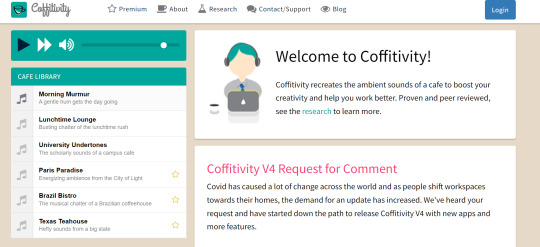
8. Pacemaker Planner
Remember how I mentioned that breaking your goals down makes NaNoWriMo easier? That might seem impossible if you’re not usually making lists and goals for yourself outside your writing routine.
Pacemaker Planner removes the guesswork. If you give it your overall word count, your final deadline (November 30), and how much time you estimate you’ll have for your writing each day, it’ll calculate your daily word count for you.
The graphing option also adds more flexibility to your goals. Let’s say you’ll be more free in the middle of November than the beginning or end. Select the Mountain Hike strategy. The program recalculates your daily goals according to your preferred writing strategy so you’ll get higher word counts when you’re actually free to write.
The free version is great for NaNoWriMo purposes, but there’s also a Premium version you can get to plan your full yearly calendar and daily schedule, if you enjoy the program.
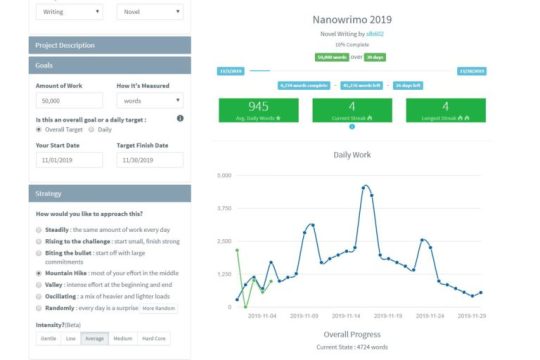
-----
You don’t have to cross your fingers and hope to conquer NaNoWriMo this year. Try these tools while they’re still time to explore your options. Whether you want to plan the whole month or turn your word count into a game, you’ll have more success after seeing which tools are at your disposal.
#nanowrimo#nanowrimo 2023#nanowrimo resources#nanowrimo tips#writer's block#writeblr#writing tips#writers of tumblr#writing#creative writing#writing inspiration#writing community#writing help#writing advice#writing resources#writer things#writers life#writers block#writers on tumblr#writerscommunity#resources#free resources#creative writing resources
65 notes
·
View notes
Text
spotify's algorithm is turning music tastes into homogeneous goop, here are some other ways to find new music. if you're looking for something totally anti-spotify it's not this, but there are non-spotify options too
use google to find playlists on spotify that contain at least two artists or songs you like. works best if the songs are not that common but you have to try out a few things
ex google search- "cherushii + sally shapiro playlist site:open.spotify.com"
this will return links to spotify playlists containing songs from both artists, . not all results are relevant but a lot should be
4chan's music board. don't go to /mu/ outright, no one sane wants to do that. go to the archive and search "sharethread" / "favorite" / "recommendations" / "underrated" etc. my favorite method is to search 4x4 (a term for graphs of album covers of weekly last.fm stats) and browse the last.fm threads since it's really easy to look at the graph of 16 album covers and see whether that poster's taste aligns with yours at all
link your music player to last.fm. last.fm matches you with users with similar tastes, and has a homepage with decent recommendations for artists/tracks. you can also compare your music taste with any other users and see your areas of overlap
look up interviews from your favorite artists. not just musicians but writers and visual artists too. interviewers love to ask about listening habits. i've found some of my fav stuff this way
make a separate youtube account solely for music. get high and click around. youtube has a higher concentration of music nerds than other streaming services, and a lot of people uploading underappreciated or forgotten music. great way to find actual albums instead of singles
check your fav artists' spotify profile, many make public playlists
chatgpt. I've had best results prompting it for recommendations based on a groups of artists/albums that maybe have some similarities, but are not in the same genre/cone of interest, otherwise it will just give spotify tier recommendations. if you try to make it find something similar to albums/artists that span decades or genres, it will get more creative. I've gotten some really good recommendations this way
31 notes
·
View notes
Text
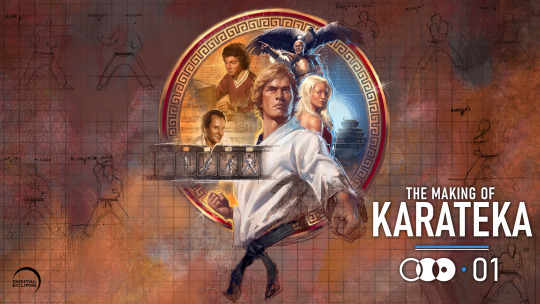
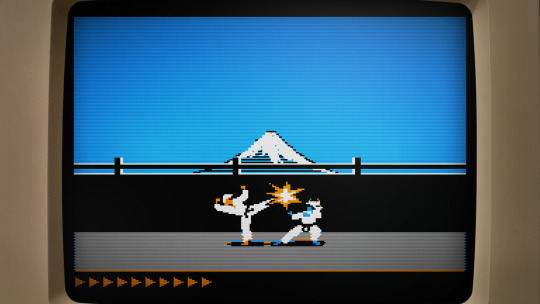
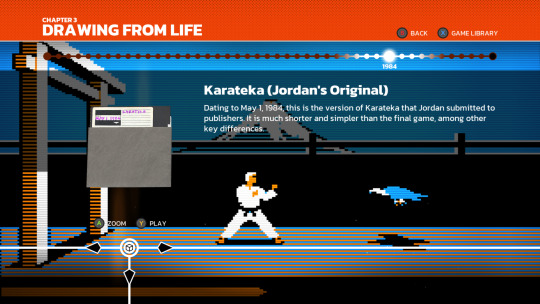


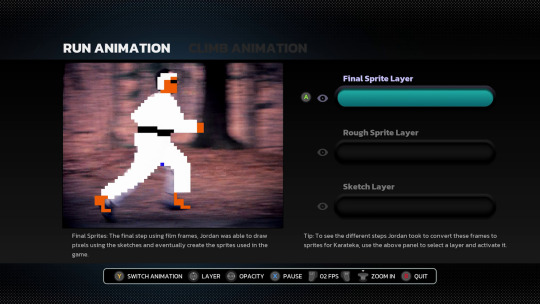
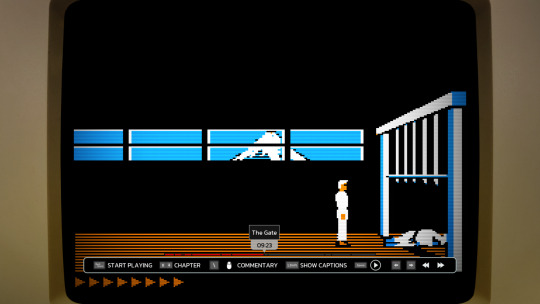
I never played Karateka in the 80s, but as a big fan of Prince of Persia and Jordan Mechner's journals, I was stoked to hear that an interactive documentary about Jordan's prototypical cinematic platformer was in the works by Digital Eclipse.
Released this week, The Making of Karateka on the surface looks like any other game you buy through Steam ($20, Windows-only), GOG, or whichever favorite store or console you prefer (available also for Xbox, PS4/5, Switch). Once the thing loads though, you really get 3 things: a documentary, the original Karateka, and a new remaster.
The documentary part is an audio-visual slideshow retelling Jordan's development story starting with his teenage years pitching his earlier title Deathbounce to the publishing house Brøderbund. It's an interesting look into the iterative process, seen through correspondence letters, journal entries, and many playable builds at various stages of completion. After we reach the eventual rejection of that title, Jordan comes back with a prototype of a visual-narrative experience unseen on home computers. We get to follow Karateka's full life cycle from pre- to post-production, ending with the conception of its sequel (which eventually turned into Prince of Persia). It's a real treasure trove! Fellow pixel artists will appreciate the many graph-paper sketches and interactive overlays of final game sprites compared to rotoscoped outlines and filmed footage. There are also video segments, from a comprehensive breakdown of the music to interviews with other developers reflecting on the impact Jordan's games had on their careers. You'll even encounter a fan letter signed by the one and only "John Romero, Disciple of the Great Jordan and worshipper of the Magnificent Mechner!" (I kid you not, you can't make this stuff up).
Perhaps just as crucial for an interactive documentary like this, you can launch any of the floppy disks in the emulator, trying out various iterations and ports of Karateka.

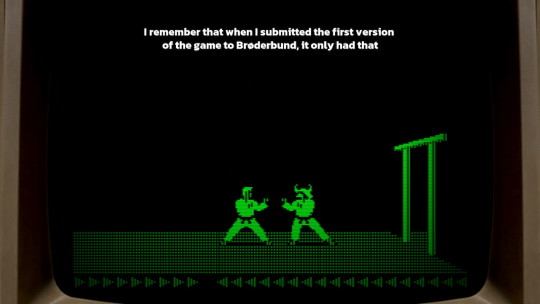
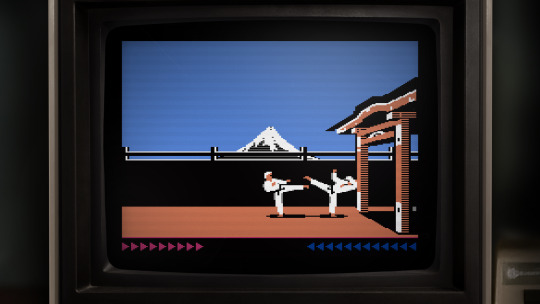
The emulation is fantastic and lets you fiddle with display settings (monochrome or color display, scanlines, pixel perfect or zoomed) as well as enhance the frame rate. You can even rewind the many deaths you will face if you've never played the game before (like me). If you spend some more time obsessing over the weird artifacts of the Apple II hi-res graphics, you might even go down the rabbit hole of realizing that on the Apple II you didn't really paint colors as much as you used different monochrome dithering patterns that the graphics display would then turn into 4 different hues. A fascinating learning experience if you include some of your own research online!
youtube
Add to this the Commodore 64 and the Atari 8-bit versions to compare how the graphics got adapted across the earlier ports and you have a nice way to relieve the mid-80s with a bit of help from modern emulation (I did beat the C64 version without rewinding though!). I'd love to see more art from the other remakes, especially the 16-bit Atari ST port, but I understand their decision to omit playable versions of those due to the lower quality on the gameplay side of the translations.
This brings us to the final part of the package, the modern remaster. Unlike the 2012 complete reimagining of the game (with 3D graphics and all), Digital Eclipse approached the remake as the ultimate port of the original to an imaginary system along the lines of a 90s VGA PC.

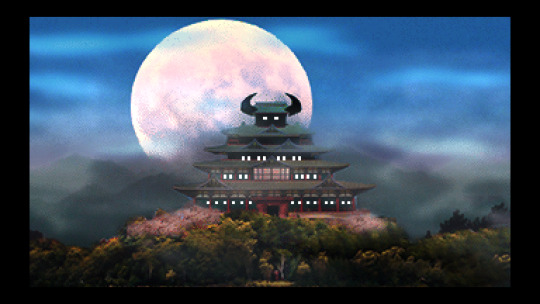


It's well done. Some of the fully-redrawn scenes are a bit overpainted for my taste (I'd prefer a pixel art rendition of the castle than a blurry photographic collage, although there were many games in the 90s that did take this approach), but the in-game graphics are really in style, including the smooth animations that are like one would imagine granted a beefier CPU. It's also a sort of director's cut with previously unseen scenes added, in particular, the battle with the leopard as a clever action-puzzle in the middle. The AI is unfortunately even less challenging than Jordan's implementation. As great as the 6-move fighting system could have been, you yet again resort to simply kicking away opponents as they tirelessly crawl into your range. There isn't even the nuance from the original where you were the one who had to approach some enemies with skilled timing. On the other hand, you now have optional goals and achievements that make the repetitive/easy combat work in your favor (stringing various combos, beating opponents or the level under a time limit …). As the Digital Eclipse president Mike Mika admits at the end of the welcome commentary mode, they didn't manage to achieve their perfect port, but they did come close.
In conclusion, I thoroughly enjoyed playing both the original as well as the remake and while the combat system lacks any sort of depth beneath its stunning animations, Karateka is instead a monumental experience for its presentation. Big characters with personality and realistic motion are displayed through cinematic camera cuts and story vignettes (3 years before Ron Gilbert came up with the word "cutscene"). There are details like animating the unfortunate falling off the cliff at the start of the game, or respectfully bowing to the first guard as they bow in return. Jordan's creative work is precious and worth the attention this release gifts it.
I highly recommend The Making of Karateka to all retro gamers and/or game developers for its immersive documentation which provides an experience that goes beyond the usual video documentaries. It's interactive—just like the subject it's talking about—something I want to see more in the future. And if the $20 by any chance seems high to you, consider that the original retailed at $35 (and that was in 1984 dollars).
youtube
77 notes
·
View notes
Text
AR Ship Week - Fandom in 2024

Another year, another shipweek, and another State of the AR Shipping Fandom post. This is the first weekly post leading up to the Alex Rider Ship Week. Just under 4 weeks to go!
This post focuses on pre-S3 fandom, since the data was scraped before the season was released, but we might do an update for post-S3 fics. For methodology, it can be found both on the graphic analysis pages and in the notes at the bottom of this post. For those only curious about the popular pairings this year (1), feel free to read right on.
This year, we have analysed a few specific shipping stats to get a look at us as a fandom.
We have also created an interactive dashboard of all the graphs for you to explore. This is where the following data was taken from, as well as some bonus visuals!
A Timeline of AO3
For a blast from the past, we took a look at the shipping timeline - the count of fics and authors per year for the top ten most popular AR ships - and found immediate proof that as a shipping fandom, we're still small enough that a few, determined people can make a difference. AR fandom's use of AO3 as its primary fandom purveyor is fairly recent, as most of its history can be found on FFnet, but with a total of just under 3k fics as of April 20th, we're gaining on FFnet's 4.5k of AR fics at a very respectable pace.
Some particular developments were:
The number of Yalex authors was about the same in 2021 - 2023 (just around 40) but the number of Yalex fics in 2022 was almost double that of 2021 and 2023. This was not due to a sudden, imported backlog that we could see but a handful of popular events/challenges and potentially the release of S2 in December of 2021.
Tom/Alex and Yassen/Ian both had a peak of fics in 2021, most likely because of the release of S1 that gave Tom a much larger part and offered an intriguing look at Yassen and Ian's potential past.
Fiona/Sabina had a huge spike in fics in 2023 due to a Femmeslash February event (2) that sent it firmly up the ranks of popular ships.
The State of the OTP
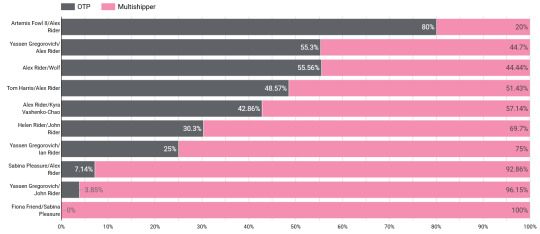
For the top ten AR ships, we also took a look at how many of the writers that had written other AR ships (and which ones) to look for interesting patterns and to see if there was any real difference to spot. As it turns out, the answer was a resounding yes:
At one extreme, we have Alexmis (Alex Rider/Artemis Fowl) which is a fandom unto itself. Only 20 percent of the writers of the pairing have written for other pairings in AR fandom fics, and Alexmis fics as a whole tend to lean more towards adding Alex to the Artemis Fowl world rather than vice versa (3).
In the middle range, we have Yalex and Alex/Wolf - two pairings about as old as the fandom itself, and which both have an OTP percentage around 55 - as well as (mostly) newcomers Tom/Alex and Kyra/Alex, both with an OTP percentage in the 40-50 range.
At the other extreme, we have Yassen/John with an OTP percentage of just 4. Fiona/Sabina does it one better with an OTP rate of 0 (!) but the sample size here is so small it makes no meaning to compare it.
So what other pairings do these writers enjoy indulging in, then?
Yalex writers really like their Yassen pairings. Out of the combined number of non-Yalex fics the Yalex authors have written, 24 percent of them are Yassen/Ian and 22 percent are Yassen/John. This means that almost half of their non-Yalex pairings feature Yassen in some way.
70 percent of John/Helen shippers have written other pairings, too - probably because of the pairing's nature as a background part of Alex's story and not necessarily the focus of a shipfic they're in. 30 percent of the fics written by John/Helen writers outside of the ship are Yalex (and 6 percent are Yassen/John).
The case is even more extreme for Yassen/John, which is firmly entwined with the Yalex pairing. 96 percent of the writers have written other AR ships, with three quarters of those fics being Yalex.
Text Analysis
Interactive dashboard with graphs and visuals
We also ran a text analysis on the shipfics to look for patterns and recurring details in the writing - first in general, then for specific ships. The amount of detail for each ship depends a lot on the sample size, which results in a detailed, varied word cloud for Yalex and somewhat less so for several of the smaller ships.
For that analysis, we recommend clicking around to explore the word clouds and get a feel for the different ships, but for the ambitious types, we have a word hunt ready as well (4):
Word Hunt, Significant Phrases edition:
Tools of the Trade:
Duct tape
Frying pan
Krav Maga
Sniper rifle
Zip ties
I Know That Reference:
Fer de Lance
Air Force
Albert Bridge
Point Blanc
Brecon Beacons
Getting Kinky:
Boxer briefs
Dimly lit
Lower lip
Pressed a kiss
Yes sir
Feel free to comment with any particularly entertaining/intriguing/otherwise just plain fun word cloud combinations you've spotted, and we will see you again next week!
______
Note on methodology:
The two Alex Rider sections (main + TV) were scraped over the course of two days in early March 2024, except for fics that were locked to AO3 users only (5). For the author specific statistics, we excluded orphan_account and anonymous authors. Median measures were chosen over average the majority of the time to account for outliers, especially in the case of the rarer pairings (6).
For ship-analysis, a fic counts under every pairing it has. This means that someone who writes Yassen/Alex, Yassen/John and Yassen/Ian in the same fic (7) will count as an author for all three pairings and under the Yalex OTP analysis, they will have an additional fic marked under both Yassen/John and Yassen/Ian.
(1) Yalex. It's Yalex. Look, we're not even going to bother posting the stats for that. It's still Yalex, trust us. Though we can talk again next year, considering how well Kyralex is currently doing post-S3.
(2) Proving that a few, determined writers can make or break the non-Yalex ship rankings. Please use this power for good; if someone manages to get Sayle/Nadia Vole or something into the top three next year, I'm outsourcing that part of the stat post to a particularly enthusiastic raccoon with a keyboard.
(3) Canonically, the wholesale kidnapping of Alex is pretty on-brand for Alex Rider supervillains so really, Artemis is in excellent company.
(4) Technically two, but there is unsurprisingly a lot of overlap between the general wordcloud and the Yalex one. For those curious, here's the Word Hunt, Yalex edition:
Adam's apple
Bottle of lube
Cock
Index finger
Nerve endings
Pale skin
Scar tissue
(5) As of April 20th, 225 out of 2961 fics were locked to AO3 users.
(6) Meaning anything non-Yalex, let's all be honest here.
(7) Because sometimes, like a particularly persistent Pokémon player, Yassen also needs to catch them all. Traumas or Riders is dealer's choice.
18 notes
·
View notes
Text
ATLA Fandom Survey 2022: Results
For those that are visually impaired or just don’t like graphs, here is a doc with all of the percentages and numbers on the following charts
I got 800 responses exactly! Here are the overall results (ID in alt text):
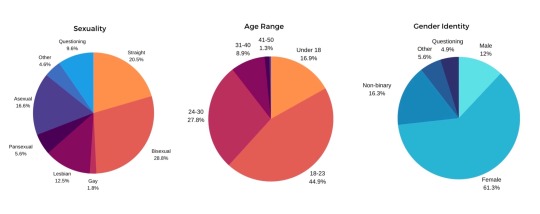

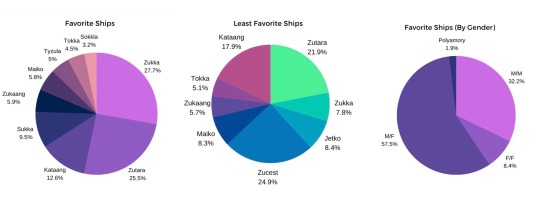
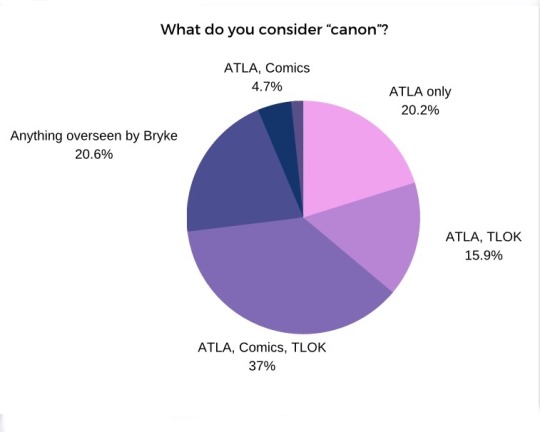
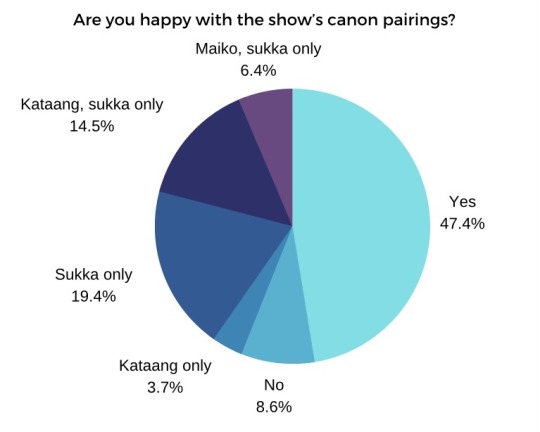
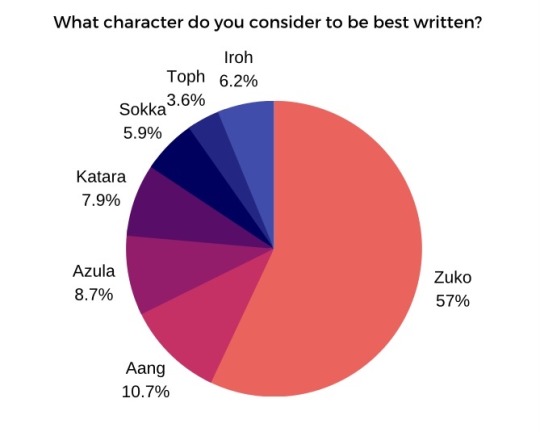
Under the cut is more detailed, summarized stats. Aka what really matters because these badly made graphs can’t tell us that much.
I’ll be making individual analyses that are Even More Detailed of the most popular answers, so check back if you’re interested.
Something pretty uplifting to see is that very, very few people said they outright didn’t like the show’s writing. It’s why I didn’t bother to make a graph on the question of whether or not people were happy with the show’s writing. There might be a lot of squabbles that happens in this fandom but at least we can all fall back on a shared love for this show. Love doesn’t mean lacking criticism, of course.
Shipping Stats
I’ll do this first since i know that’s what a lot of you are here for, lol!! To no one’s surprise, zutara and zukka dominated the charts in every way. They just can’t leave people’s minds.
Zutaras were quite uniform in this survey. If you like zutara, there is a strong chance you identify as female, specifically an 82% chance (big chance!). The most common age range is 24-30 years old, but 18-23 is close behind. There is a significant number of people between 31-40. The most common sexualities are split almost halfway between bisexual and straight. There is also an even split between favorite characters of Zuko and Katara. The majority are happy with sukka as a canon pairing, but not kataang or maiko. As everyone and their mothers expected, the most disliked pairing is kataang. The majority only accept the original show as being canon.
Kataang shipper’s stats were similar to zutaras, and yet so different. It’s only slightly younger, the majority being 18-23, but only a slightly larger number of teenagers. The majority identify as female, but was a more significant number of male and non-binary respondents than zutaras. Their favorite character is largely Aang and least favorite is largely Azula. A staggering amount are (understandably) happy with the show’s canon pairings. Taking up the mantle of zutara’s long-run rival, zutara is their least favorite pairing. The majority of them accept any material overseen by bryke to be canon.
Where zutaras and kataangs had very consistent stats, zukka shippers are much more of a mixed bag. This is a young fanbase, with the majority being 18-23, but a large amount also indicated they are under 18. The majority of zukka shippers are LGBT+. Zuko was largely the most popular character, with Sokka only receiving half the votes that Zuko did. The majority of them are happy with all three canon pairings. Zukkas don’t like problematic ships, with zucest being the most disliked pairing, and zukaang being the third most disliked. The second most disliked was the rival ship zutara. The majority of them take all ATLA-verse material as canon.
Zukaang shippers are like zukkas in that they are also a mixed bag in terms of demographics. The majority are LGBT+. Another young fanbase, lot of them are young adults, with the majority being 18-23. Aang once again gets a spotlight as the favorite character. An equal amount dislike zukka and zutara respectively. The majority only take the original ATLA show as being canon.
Sukka shippers are so diverse that I barely have anything to say. That is what I have to say. The only ones that stand out is that the majority of respondents are female and between 18-24. There is the one other person that’s 51-60 in this bunch! The majority like Sokka the most. A lot dislike Jet, but Zhao is still the king of least favorites here.
Maiko shippers are only united in some areas. The age ranges wildly, with the majority being 24-30, but there is a good number of other age ranges, including the sole respondent that is 51-60. A staggering majority identify as female and/or straight, but bisexual maiko shippers are not far behind. Maikos love Mai, with the majority choosing her as a favorite, but a lot of them don’t like Jet. Just like kataangs, most are happy with the canon pairings. Zutara is the least favorite, but zukka is not far behind. The fan base is split in what they consider to be canon.
Some more popular pairings were tyzula, tokka, sokkla, jetko, and mailee. None had enough responses to get solid metrics, but here are some stats that stand out. Tyzula respondents were mostly lesbians!! 🎉 🎉🎉 Most jetko respondents were non-binary. Sokkla respondents really don’t like Iroh and had higher than average male respondents.
The majority of people who selected “I don’t ship” identified as male and/or straight. Toph and Iroh are the most popular in this bunch, while there is no shared ground on a least favorite. The majority don’t have a least favorite ship, but zutara was not far behind. They are mostly happy with the show’s canon pairings and writing, and take anything overseen by bryke as canon.
Character Stats
I’m so glad I let people insert options for their least favorite characters. Some honorable mentions: The old man who snitched on Haru, Haru’s mustache, the mayor in Avatar Day, Aunt Wu, the circus master that abused Appa, Hahn, Sparky Sparky Boom Man, Kiyi, the two tribes in The Great Divide, Kei Lo, and Meng. Some of the responses had very lavish insults attached to them.
The demographics of Zuko fans are similar to that of the overall survey, likely due to the fact that there were so many respondents that chose him as their favorite, with one exception being that there were more respondents than average that identify as asexual. Zuko fans, understandably, really don’t like Zhao and Ozai. Most shippers that have Zuko as one half of their pairing select Zuko as their favorite rather than the other half, such as Mai or Sokka.
I don’t have anything interesting to say about Katara fans as they were essentially a 1:1 reflection of the zutara stats.
Sokka fans are young, a large majority of them being under 18. The majority are also, unsurprisingly, zukka shippers, and the stats reflect as such. More respondents than average selected Jet as their least favorite character.
Toph fans were largely diverse in demographics, reflecting the stats of the overall survey, but with significantly more respondents that are under 18. The favorite pairings was close between zukka, tokka, kataang, and people that don’t ship. Toph fans are generally happy with the overall franchise.
Other observations:
One of my mini hypotheses was confirmed: A whole lot more people picked zucest as their least favorite pairing instead of zukaang after I added it to the list of options, despite there always being an option to type it in. I’m talking a staggering number.
At around 230 responses, I added zucest to the list of options. My personal theory on that is that anyone that doesn’t have a strong personal opinion about one specific ship will instead choose the most “problematic” of the bunch, zukaang because of the age gap and zucest because of the, well, ‘cest. That’s not to say that there weren’t people that didn’t pick zukaang after zucest was added and vice versa, but the difference in numbers was immediate.
A similar thing added to Ozai: a whole lot more people voted for the local Phoenix King after I included him into the list of options. Whatever was on the list of options was crucial to what the final number will be, and I’ll keep this in mind next time I do this.
I did put a lot of the question answers on shuffle, so that the listed answers are always in a random order. Hopefully that mitigated whatever tf that one thing I learned about in my research class where people have a bias to select the first option. Something-bias.
A few people admitted to not having seen the show and were only relying on information they got from fandom. Not judging, but that did make me curious about how common that is…
Final Notes
By this time next year, the new live action show will likely have already started to release. The movie will be on its way, and new graphic novels are coming along quickly. Old fans and new watchers of the original series will still be around. Needless to say, this fandom is NOT going anywhere.
I’m planning on doing this next year, and I’ll continue to tinker with the survey I made, adding new questions. I got some good suggestions on things to add, too. How much things have changed by next year will be an interesting question to answer.
#edit; PLEASE don’t start discourse on this post LMFAO#that’s not what this is about!!!!#atla#avatar the last airbender#aang#zuko#sokka#katara#toph beifong#suki#zutara#zukka#kataang#maiko#zukaang#fandom stats
492 notes
·
View notes
Text
This is bullshit and i wanna talk about why
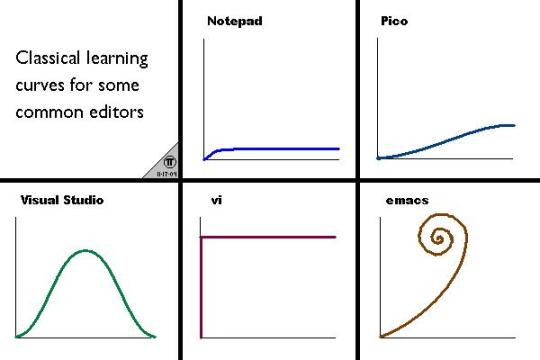
Notepad: this is fine. There are only a couple features and they're pretty obvious.
Pico, VS: idk haven't used them but it sounds right compared to nano and vscode respectively..
Vi(m): the reality is, you will learn hjkli<esc> and that is all you will use for months. Then gradually find more features, by accident or by google. I get the meme, "haha vi users have to remember all those keybinds", but it's just not like that at the start.
Emacs: ugh, where to even begin. First of all this graph demands poetic interpretation, because proficiency cannot in fact bend time backwards in a spiral. Second, Emacs is even more like notepad ootb than vi is. It has a menu bar at the top, what could be more noob friendly than that? No, the Emacs graph here should look more similar to the Visual Studio graph, or perhaps a taller version of the Pico model.
The problem these graphs exist to ignore is that
All editors are quite boring
And all learning curves are simple transformations of each other.
23 notes
·
View notes